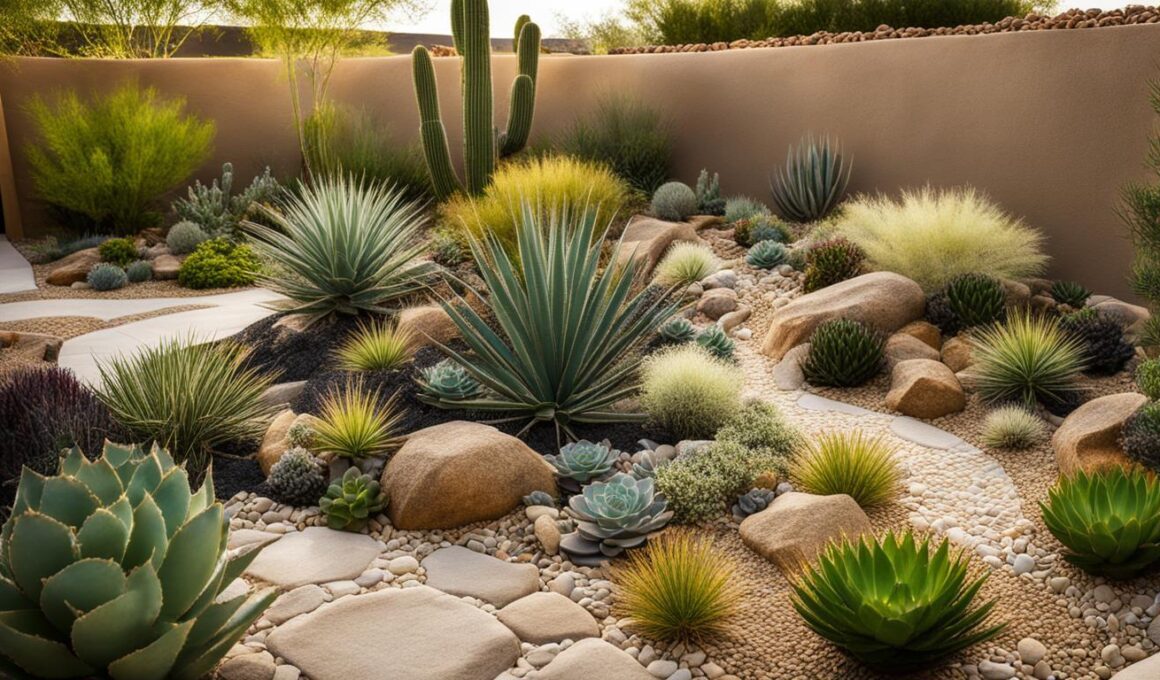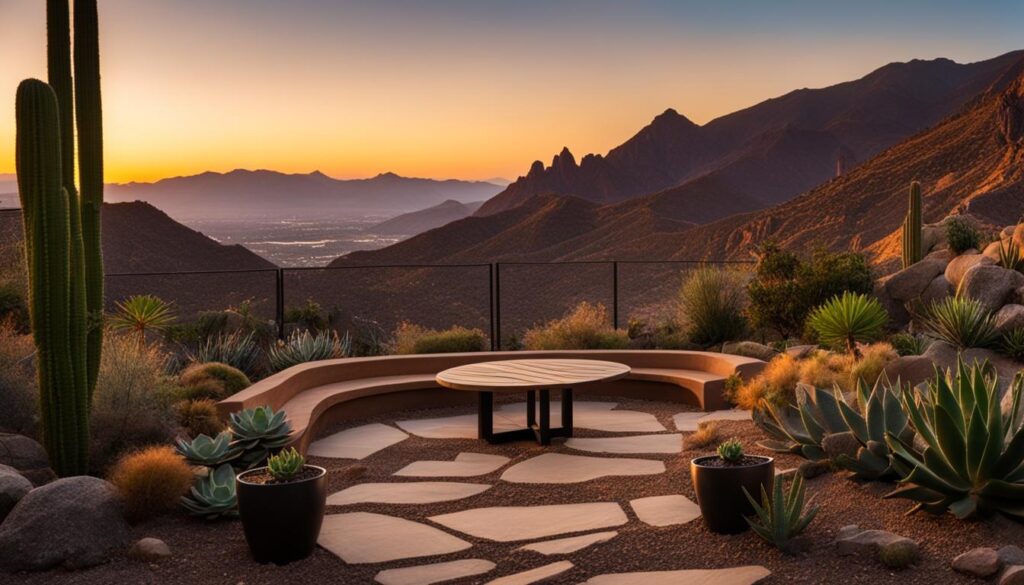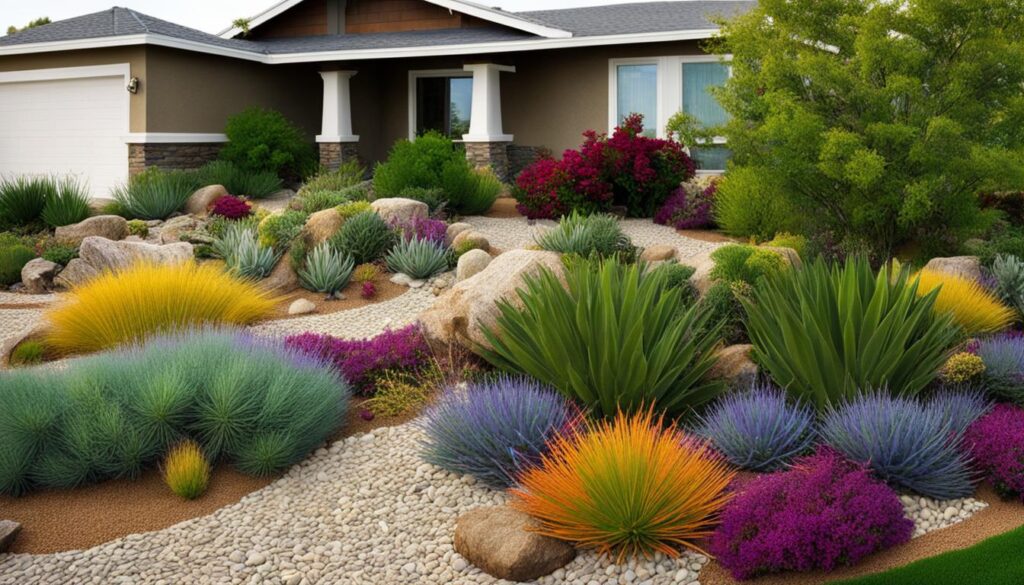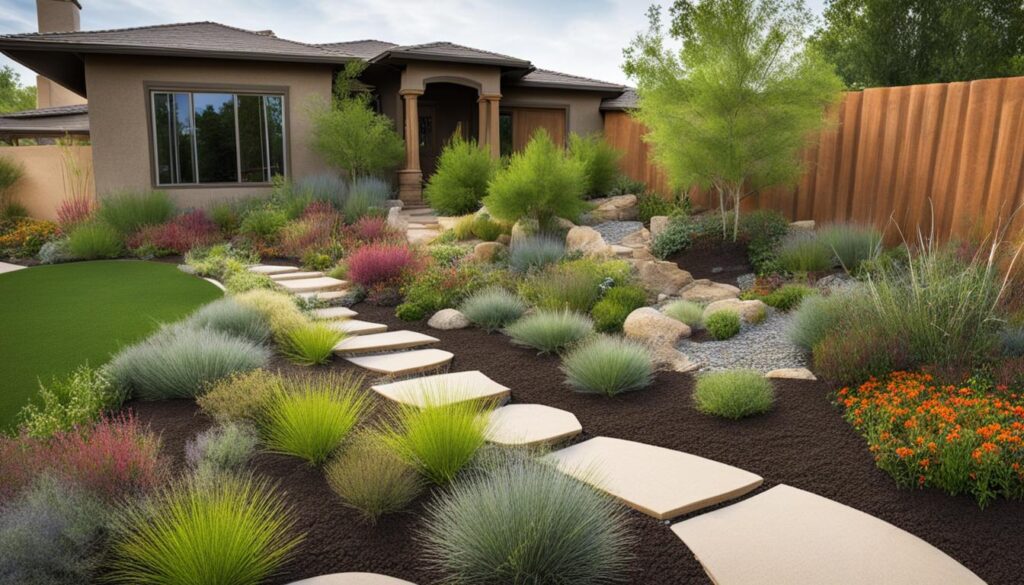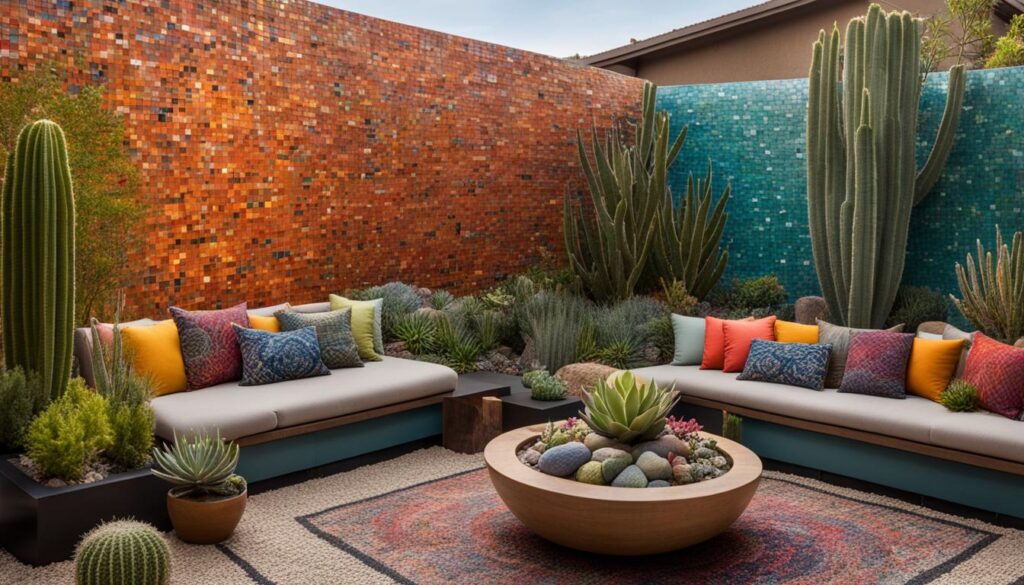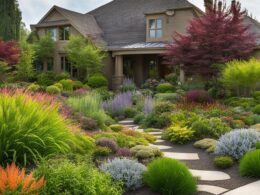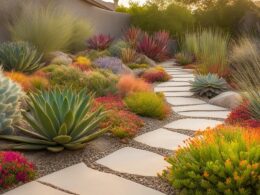Are you looking to transform your small outdoor space into a beautiful and sustainable garden? Xeriscape design is the perfect approach for small spaces, combining water-wise gardening techniques with curb appeal and sustainability. By incorporating native plants, mulch, rocks, and drip irrigation systems, you can create a stunning landscape that maximizes the use of limited space.
Key Takeaways:
- Xeriscape design is an ideal landscaping approach for small spaces.
- By incorporating native plants, mulch, rocks, and drip irrigation systems, you can create a beautiful and low-maintenance garden.
- Designing small gardens with focal points, furniture groupings, and paths can maximize the impact of limited space.
- Water-wise techniques such as xeriscaping, native plants, mulching, and drip irrigation help conserve water and promote drought-tolerant plants.
- Xeriscape design enhances curb appeal with elements like focal points, container gardens, and attractive materials.
With xeriscape design, you can create a sustainable outdoor space that utilizes eco-friendly practices such as rainwater harvesting, composting, and the use of eco-friendly materials. Additionally, by designing functional outdoor living spaces with seating areas, garden paths, and multitasking elements, you can maximize the use of your small yard or garden for entertainment and relaxation.
Embrace the beauty of xeriscape design, enhance curb appeal, and create a sustainable outdoor oasis in your small space!
Designing Small Gardens for Maximum Impact
When it comes to small garden landscaping, there are several strategies you can employ to maximize the impact of your space. By carefully planning and incorporating specific elements, you can create an outdoor area that feels elevated and visually appealing.
One approach is to add architectural elements such as pergolas, arbors, or even tall shrubs. These structures and plants can give your small garden an elevated feel and create a focal point that draws the eye. Additionally, breaking up open areas with furniture groupings and paths can make a small backyard landscape feel larger and more dynamic.
Another way to create depth and division in a small space is by designing intimate nooks. These cozy corners can be transformed into reading areas or tranquil spots for relaxation. By strategically placing seating and incorporating greenery or decorative elements, you can add visual interest and make the most of your limited space.
Don’t be afraid to experiment with bold, bright flowers and incorporate long, straight lines in your small garden design. These techniques can create visual interest and make your space appear bigger than it actually is. Whether it’s through the use of vibrant flower beds or straight-lined pathways, you can achieve a visually stunning small garden that leaves a lasting impact.
Key points:
- Incorporate architectural elements like pergolas and arbors for an elevated feel.
- Create intimate nooks for reading or relaxation to add depth and division.
- Experiment with bold flowers and long, straight lines for visual interest.
- Break up open areas with furniture groupings and paths to make the space feel larger.
Embracing Water-wise Techniques
When it comes to xeriscaping, water conservation is a fundamental principle. By implementing low-water techniques and utilizing native plants, mulch, and drip irrigation systems, you can create a beautiful and sustainable garden that requires minimal watering. Xeriscaping is an excellent choice for small spaces, as it allows you to maximize the use of limited resources while still enjoying a lush and vibrant outdoor space.
Choosing native plants that are well-adapted to your climate is key to creating a low-water garden. These plants have evolved to thrive in your region, meaning they will require less water and maintenance compared to non-native species. Additionally, spreading a layer of mulch around your plants can significantly reduce evaporation, helping to retain moisture in the soil and reduce the need for frequent watering.
An essential component of xeriscaping is the use of drip irrigation systems. These systems deliver water directly to the roots of plants, minimizing water waste through evaporation or runoff. Drip irrigation also ensures that water is used most efficiently, providing targeted hydration to specific plants or areas of your garden. By incorporating these water-wise techniques into your xeriscape design, you can create a resilient and eco-friendly outdoor space that thrives even in arid climates.
Benefits of Embracing Water-wise Techniques
- Reduces water consumption and promotes conservation
- Creates a sustainable and environmentally friendly garden
- Requires minimal maintenance and watering
- Promotes the growth of drought-tolerant native plants
- Helps to prevent soil erosion and maintain soil health
When it comes to water-wise gardening, xeriscaping is the way to go. By incorporating low-water techniques, native plants, mulch, and drip irrigation, you can create a stunning and sustainable garden that conserves water, reduces maintenance, and supports the growth of drought-tolerant plants.
Enhancing Curb Appeal with Xeriscape Design
When it comes to creating an inviting and visually appealing outdoor space, curb appeal plays a crucial role. With xeriscape design, you can enhance the curb appeal of your small space and make a lasting impression. By incorporating landscaping ideas that focus on focal points and container gardens, you can transform your front yard into a stunning landscape.
Creating Focal Points
One effective way to enhance curb appeal is to create focal points in your front yard. These can be eye-catching elements that draw attention and add visual interest. Consider adding a statement piece like a sculpture, fountain, or large planters to create a focal point. This will not only add a touch of elegance to your outdoor space but also make it more inviting for guests and passersby.
Container Gardens
Another landscaping idea that can greatly enhance curb appeal is the use of container gardens. These portable gardens add a pop of color and greenery to your front yard, making it more vibrant and welcoming. You can choose a variety of plants and flowers that complement your home’s exterior and create a beautiful display. Grouping containers of different sizes and heights can add depth and dimension to your outdoor space.
By incorporating these landscaping ideas, you can transform your small front yard into a visually appealing and inviting space. Whether it’s creating focal points or adding container gardens, xeriscape design allows you to enhance the curb appeal of your home while promoting sustainability and water-wise gardening.
Creating a Sustainable Outdoor Space
Incorporating sustainable practices into your outdoor space can not only help preserve the environment but also create a more self-sufficient and eco-friendly garden. By implementing techniques such as rainwater harvesting, composting, and using eco-friendly materials, you can minimize your carbon footprint and promote a greener lifestyle.
1. Rainwater Harvesting
Rainwater harvesting is an effective way to conserve water and reduce your reliance on municipal water sources. By installing rain barrels or cisterns, you can collect and store rainwater for future use in watering your plants. This not only reduces your water bill but also helps to alleviate the strain on local water resources.
2. Composting
Composting is an excellent way to recycle organic waste and create nutrient-rich soil for your garden. By composting food scraps, yard trimmings, and other organic materials, you can divert waste from landfills and produce a valuable resource for your plants. Compost adds nutrients to the soil, improves its structure, and enhances its ability to retain moisture.
3. Eco-friendly Materials
Choosing eco-friendly materials for your outdoor space can have a positive impact on the environment. Opt for sustainable options such as recycled plastic, reclaimed wood, or natural stone for your furniture and structures. Additionally, consider using environmentally friendly paints, stains, and sealants that are low in volatile organic compounds (VOCs) to minimize air pollution.
By incorporating these sustainable practices into your outdoor space, you can create a more environmentally conscious and self-sufficient garden. Rainwater harvesting, composting, and the use of eco-friendly materials are just a few ways you can make a positive impact on the planet while enjoying the beauty of your outdoor oasis.
Designing Functional Outdoor Living Spaces
When it comes to maximizing the potential of your small outdoor space, designing functional outdoor living areas is key. By creating seating areas, garden paths, and incorporating multitasking elements, you can transform your limited space into a versatile and enjoyable environment.
Creating Outdoor Entertaining Spaces
One of the main goals in designing functional outdoor living spaces is to create areas that are suitable for entertaining. Whether you’re hosting a small gathering or enjoying a quiet evening outdoors, having designated seating areas is essential. Consider incorporating comfortable seating options such as lounge chairs or outdoor sofas that can accommodate your guests. To add a touch of coziness and ambiance, you can also include fire pits or outdoor heaters.
Utilizing Garden Paths
Garden paths serve both a functional and aesthetic purpose in small outdoor spaces. They not only provide a clear passage from one area to another but also add visual interest and structure to your garden. Consider using materials such as stepping stones, gravel, or pavers to create paths that blend seamlessly with your overall design. By incorporating curves and varying widths, you can create a sense of intrigue and invite exploration within your outdoor space.
Incorporating Multitasking Elements
In small outdoor spaces, it’s essential to make the most of every square foot. Incorporating multitasking elements can help maximize functionality and versatility. Vertical gardening, for example, allows you to grow plants upwards, saving valuable ground space. You can utilize trellises, wall-mounted planters, or hanging baskets to create a vertical garden that adds beauty and greenery to your outdoor area. Raised beds are another great option, as they provide a designated space for growing herbs, vegetables, or flowers while also adding depth and dimension to your garden.
By considering the needs and desires you have for your outdoor space, you can design functional areas that cater to your lifestyle. Creating outdoor entertaining spaces, utilizing garden paths, and incorporating multitasking elements are just a few ways to make the most of your small outdoor space. With careful planning and attention to detail, your outdoor living area can become a haven for relaxation, socializing, and enjoyment.
How Can I Use Hardscape Elements in Xeriscape Design for Small Spaces?
When incorporating hardscape in xeriscape design for small spaces, consider using materials like gravel, rocks, and pavers to create paths, patios, and retaining walls. These elements can add structure and visual interest while reducing the need for water and maintenance in your xeriscape garden.
Conclusion
Xeriscape design offers a multitude of possibilities for transforming small spaces into stunning and sustainable outdoor areas. Whether you have a tiny yard or a small garden, you can utilize water-wise techniques, enhance curb appeal, and create functional outdoor living spaces to make the most of your space.
By embracing xeriscape design, you can create a beautiful and eco-friendly garden that conserves water and promotes sustainability. Incorporating native plants, mulch, and drip irrigation systems will not only reduce your water consumption but also support the growth of drought-tolerant plants.
Moreover, xeriscape design can greatly enhance the curb appeal of your small space. Adding focal points, container gardens, and art installations will transform your front yard into an inviting entrance that leaves a lasting impression.
When it comes to designing functional outdoor living spaces, consider incorporating seating areas, garden paths, and multitasking elements. These elements will provide you with comfortable spaces for entertaining and relaxing, while maximizing the use of your small outdoor area.
Embrace the beauty of xeriscape design for small spaces and create a sustainable oasis that combines water-wise gardening, curb appeal, and environmental consciousness. Unlock the full potential of your small yard or garden and enjoy the benefits of a stunning, eco-friendly outdoor space.





